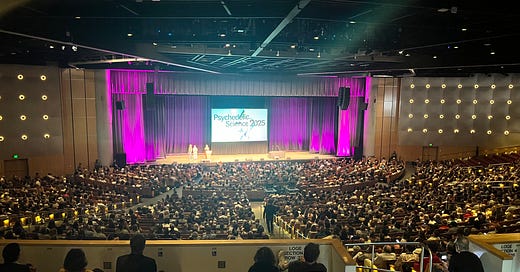I just attended the 2025 Psychedelic Science conference in Denver. I thought I would offer some initial thoughts now and develop my ideas about it more in future newsletters. I didn’t attend the massive 2023 PS conference which included over 12,000 attendees and was seen as a watershed moment for the psychedelic movement. Two years later, the wave seems to have crested, largely due to the failure of MDMA-assisted psychotherapy to gain FDA approval last year. The number of participants this year was estimated to be around 8,000. That’s still a lot of people, and there’s still an amazing flotilla of companies, therapists, retreat centers, and scientific research projects surging forward — even if scientific research funded by the US government was recently deprioritized in a key House appropriations bill. But, as I hope to explore in what follows, the movement as a whole seems to have reached an uncertain precipice.
As regular readers know, my first book, Breaking Open the Head (2002), was on psychedelic shamanism, which I also explored in my second, 2012: The Return of Quetzalcoatl. I co-authored When Plants Dream (2019), on ayahuasca. Apparently, I’ve been reflecting on this subject for a long time. When Breaking Open the Head came out, the subject of psychedelics was still marginalized and taboo, particularly on the East Coast. It felt dangerous to speak and write openly on the subject. My first book helped break that taboo for the culture.
I have found it anthropologically and philosophically fascinating, as well as weird, to witness the rapidly expanding cultural and entrepreneurial focus on this area over the last decade — far beyond what I might have predicted when I wrote my first books. You literally could not even discuss psychedelics in academic or mainstream settings back then. Now there are brand new, well-funded centers exploring the subject at Harvard, Johns Hopkins, Berkeley, and so on.
For many years, I have been concerned about the direction of the psychedelic movement on multiple levels. Fifteen years ago, I tried to build an alternative media infrastructure and social movement which integrated psychedelics, non-ordinary states, and visionary plants into a larger, more holistic paradigm for addressing the polycrisis, integrating permaculture, local currencies, and so on. I saw the progressive wealth-holders who could have supported this initiative — or other movements bringing together the exploration of consciousness with indigenous knowledge systems and social justice movements — become totally entranced by the renegade glamor of psychedelics. They started to pour funds into the psychedelic ecosystem. This included nonprofits like Rick Doblin’s Multidisciplinary Association for Psychedelic Studies (MAPS) as well as nascent for-profit corporations like Compass Pathways and Atai Life Sciences.
I would say for many of these wealth-holders, psychedelics provides a way for them to contribute to an exciting, idealistic project that promises consciousness change — as well as, vaguely, social change down the line. Investments into psychedelic companies were a radical and vanguard act, but might also have serious financial rewards, even exponential ones, eventually. At the same time, the psychedelic movement didn’t directly threaten the prevailing political, economic, and social forces that maintain elite wealth, power, and privilege. In fact, as the movement grew, deluxe, high-priced retreats started to proliferate where people might drop $6,000 - $20,000 to do ceremonies with an indigenous practitioner who had lived most of their life in a simple hut in the jungle.
In America, the psychedelic movement chose a strategic path for normalizing and eventually legalizing these substances through a focus on scientific research designed to prove the benefits of psychedelics and related compounds for a variety of mental health issues, including depression, PTSD, and end-of-life anxiety. MAPS’ goal was FDA approval of MDMA-assisted therapy as the first stage in a broader rehabilitation and legitimization of psychedelics — a project that requires tens of millions of dollars in itself. Soon, the psychedelic movement’s focus was extended to also bring psychedelics into the American cult of self-optimization, with microdoses touted as beneficial for innovation in business and creative work, exciting many leaders in the corporate and tech world.
After 2006 or so, the presentations at conferences put on by MAPS and Horizons in New York City became increasingly — almost intentionally — dull, repetitive, and pedantic, unless you were a scientific researcher in the field. The underground psychedelic community shared a general understanding that the plan was to “Trojan Horse” these substances into the mass culture, using the medicalization and optimization models. We tended to believe that large-scale psychedelic use would be innately beneficial for society, potentially bringing about a large-scale consciousness change toward peace, social justice, and regenerative ecological practices. The general vibe was that we should put away and sweep the more wild edges and liminal zones of psychedelic-inspired thought (represented by Terence McKenna, Robert Anton Wilson, José Argüelles, and so on) under the carpet: We needed the doctors and scientists to win this battle for us.
Among the topics left on the cutting room floor as the psychedelic movement picked up momentum and became a multi-billion-dollar enterprise was the trickster-ish nature of initiatory exploration with visionary plants and entheogenic compounds. This was something I found myself forced to focus on in my books, due to many shocking subjective experiences. Essentially, psychedelics and visionary plants produce a range of unpredictable psychic and paranormal effects. The list includes everything from telepathy to massive synchronicities to telekinesis, to the “magical” manifestation of objects, to spirit possession and weather modification.
Many in the psychedelic and shamanic community know this, of course. But because the effects are unpredictable, they do not fit easily into scientific categorization.
Keep reading with a 7-day free trial
Subscribe to Liminal News With Daniel Pinchbeck to keep reading this post and get 7 days of free access to the full post archives.





